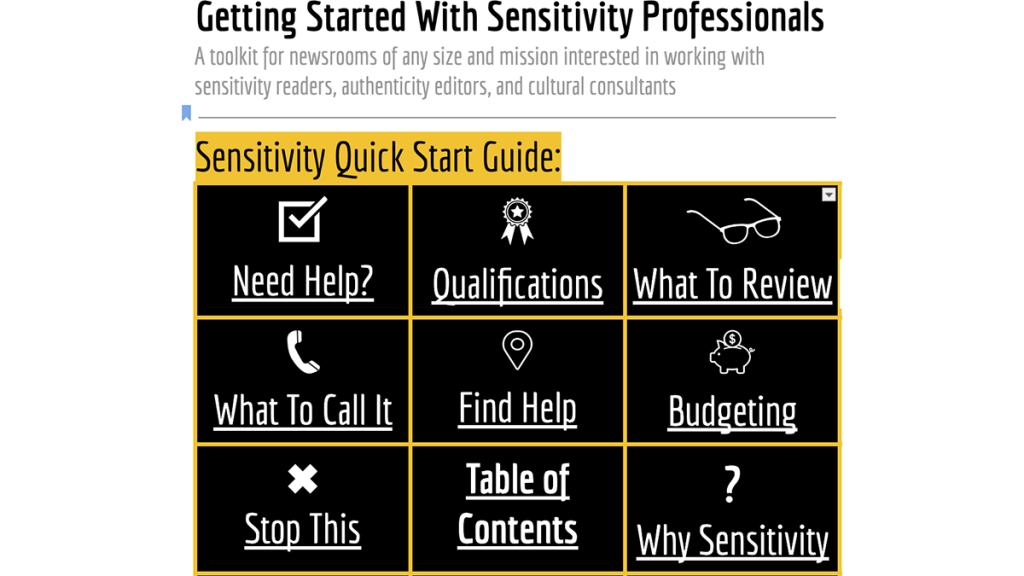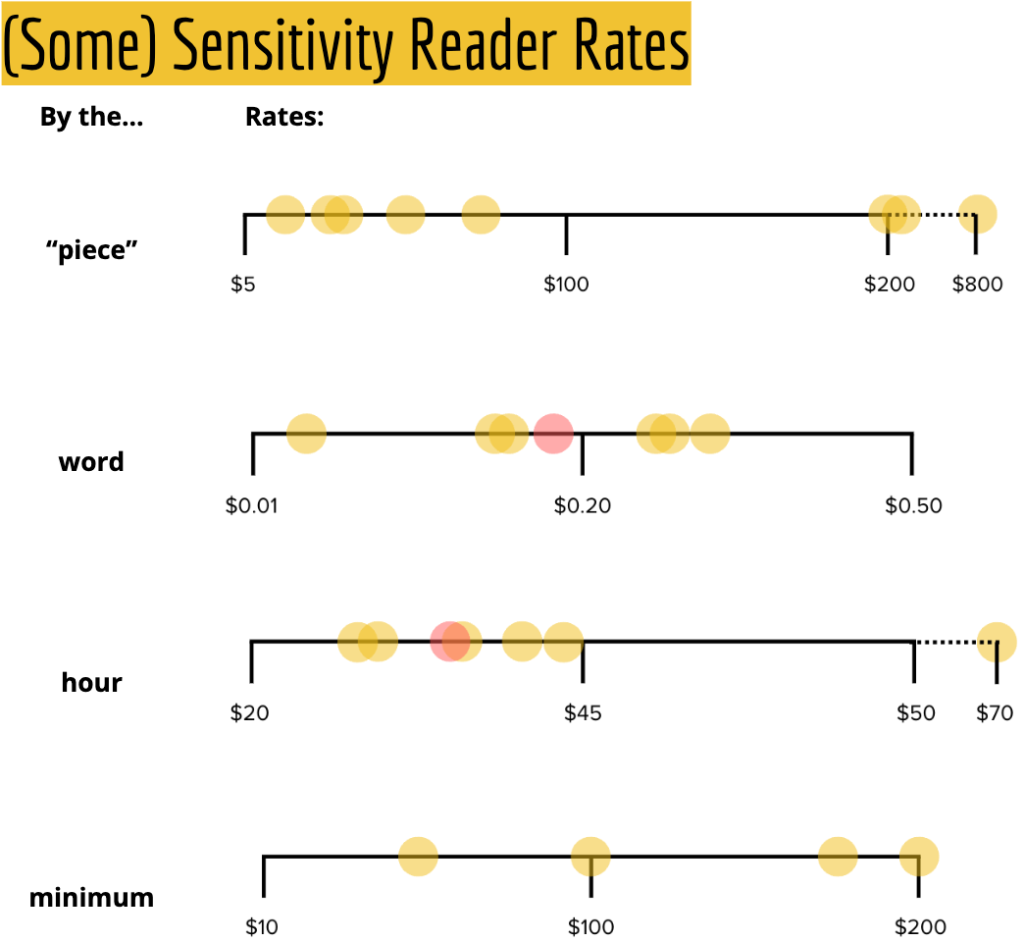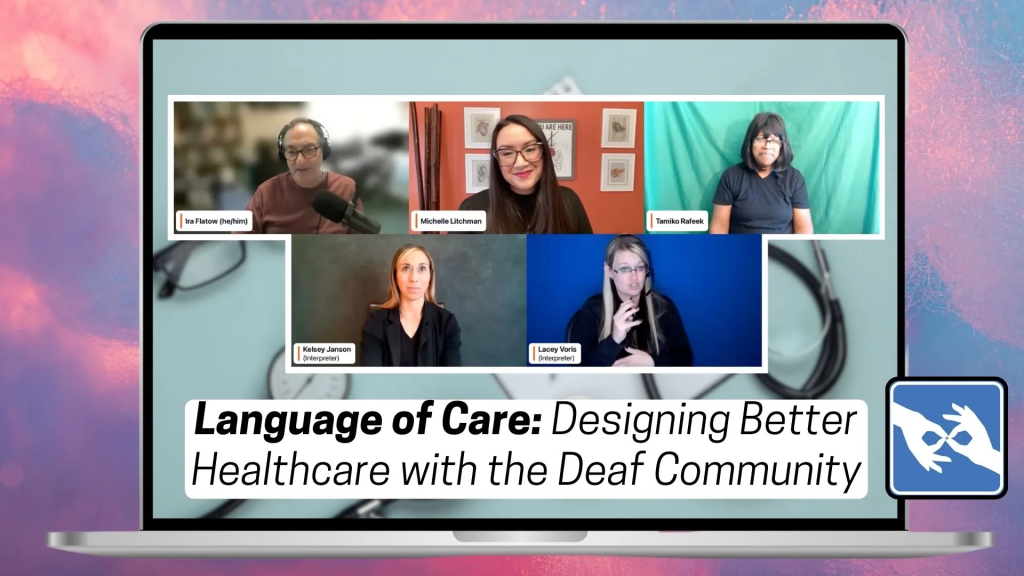
How to hire a sensitivity editor
The identity readers, editors, and consultants you can hire right now
Getting Started With Sensitivity Readers is a toolkit for those who have decided that it is time to ask and pay for help representing another identity fairly and accurately in their journalism.
When we report on issues that are close to identity, we touch upon some tricky stuff. Identities are the core of some of our most contentious and charged social issues, and are the premise for inequality among communities defined by their race, sex, religion, politics, poverty, crime, power, oppression, and more. The identity of a reader, viewer, or listener can radically change how our journalism is received, whether it does harm or builds trust, and whether it is shared among the communities you hope to serve.
Sensitivity readers are experts at providing feedback through the lens of identity—hire them when you can.
Sensitivity professionals can help you understand and predict how your journalism will impact both diverse audiences as well as the communities represented in it. Sensitivity professionals come from many different identities, have a huge array of skill sets, and work in a variety of sectors within and beyond journalism. They can be staffed or freelance, supported under a grant or hidden in your marketing budget, brought in early as co-creators or hired to finishline a draft. Regardless of the particular arrangement, you’ll receive well-supported, identity-informed feedback that will reduce the likelihood of causing harm through marginalization and exclusion.
Sensitivity readers are experts at providing feedback through the lens of identity—hire them when you can.
It is never too early, and is in fact rarely too late in the life of a project to reduce unintentional harm to communities portrayed in our storytelling, particularly if the identity communities you feature in your story have a history of marginalization or exploitation. It’s also never too early to remove this burden from minority-identifying staff who don’t get fairly compensated for it.
What is in the sensitivity reader toolkit?
This toolkit is intended to be a guide to working with a community of talented journalists and editors who possess a special combination of scholarship and lived experience around the nature of identity and harm in media. It’s also intended to further professionalize the sensitivity work these folks do by describing a continuum of roles, various and customizable scopes of work, providing base rates and level-ups, and establishing minimum and exemplary qualifications for selecting sensitivity professionals.

Depending on where you are in your journey towards asking for qualified identity help, you might want to skip to the following guides within the toolkit to cut right to the chase
- Do You Need A Sensitivity Reader?
A crude checklist of risk - What Do We Call This Thing?
Role definitions in sensitivity work - What You Can Ask A Sensitivity Professional To Review
In a word, everything. - What Makes A Great Sensitivity Reader?
Identity, scholarship, editorial experience - Where To Hide Or Build Sensitivity Work In The Budget
Freelance, honoraria, marketing, outreach, you name it! - What To Pay, How To Argue A Higher Rate
Rates are reasonable, so is asking for more money for intense content - For The Skeptics: Risks And Alternatives
Sensitivity work is not a replacement for systematic reform - Recognizing And Avoiding Unpaid Sensitivity Work
Don’t exploit colleagues or get burned out - Random Tidbits:
- Boilerplate slack messages to dodge thoughtless gut checks
- Willie Nelson’s son as authenticity consultant for Star Is Born
- A bingo card as sensitivity tool
Who is this sensitivity guide for?
The identity-curious working in and around journalism, including:
- Journalists who are eager to do better on their next story that features one or more marginalized communities to which they do not belong
- Content creators who are interested in hiring a docent to help them navigate and accurately portray communities they know nothing about, marginalized or otherwise
- Directors and editors interested in defining staffed roles for editorial equity oversight
- Grant writers who need to make the argument for financial support for sensitivity readers, cultural consultants, or equity editors
- Any newsroom staff looking to scope a review of a project before it’s too late, using their existing budget and resources
- Newsroom staff who are tired of being asked for unpaid gut checks about offensive or problemattic content, as well as staff who love this work and want it to be compensated as a part of their role.
- Freelance journalists, editors, and scholars interested in adding sensitivity work to their list of services, those who want to be compensated fairly for that work, and those looking to grow into sensitivity roles through training and work experience.
- Others, too. Help share it: bit.ly/sensitivityreaders
Wait, what are sensitivity professionals again?
Sensitivity professionals work to prevent or reduce the further marginalization of one or more identity communities due to the use of harmful or excluding language, narratives, stereotypes, representations, channels, and/or misinformation in formal communication. Some work as editors, some as consultants, some will look at your run of show and make a list of suggested disability accommodations, others will simply read your article draft and write you a thoughtful email about identity capitalization. This work can be as bespoke or off-the-shelf as you like.
There are a LOT of different types of sensitivity professionals out there, and they are called by dozens of titles and roles: sensitivity reader, equity editor, cultural consultant, inclusivity consultant, identity editor, accessibility consultant. These are roses by different names, and each conveys a different specialty, skillset, permanence, and pay scale. Among many other things, this kit provides guidance for navigating and naming different types of sensitivity work, in part with the hopes of opening minds about how early, often, and in what capacity you can seek out identity and live-experience expertise. Sensitivity work can go way beyond line edits.
Wait, I have thoughts about this!
Awesome. Please share them. You can submit feedback about this toolkit to this form, or directly email us at sensitivity@sciencefriday.com. This document will remain a living document through June 2024, and revisions will be reflected in an in-document change log and credited where appropriate and requested.
Who are you and why did you make this?
I’m Ariel Zych, I wrote this as the Director of Audience at Science Friday, a small nonprofit newsroom dedicated to increasing the public’s access to science. Science Friday produces science interviews across a range of channels spanning public radio, podcast, web, newsletters, social, K12 settings, and live events.
In treating topics that disproportionately affect or feature marginalized communities, we try to reduce or prevent harm to audiences from marginalized communities and identities affected by and participating in our editorial, programmatic, and outreach work. Lived experience and identity expertise are essential to making effective determinations about how to respectfully and equitably cover or feature any identity community in our work.
The trouble is, like most newsrooms, we’re a news organization of predominantly majority-identifying staff. Even if we were a more diverse organization, there are too many facets of marginalization for all marginalized identities and lived experiences to be represented adequately among a staff of our size (about 20). Therefore, in order to ensure that we aren’t replicating or accentuating unknown harms in our coverage, we regularly contract sensitivity readers, listeners, editors, and consultants to review our development and use of language, imagery, sound, marketing efforts, and live event formats. How and when we choose to employ sensitivity readers is a matter of both strategy and convenience: Science Friday experiences the constraints shared by many nonprofit newsrooms as a resource-limited, deadline-driven, and audience-supported enterprise.

I’ve been working at Science Friday for over a decade, and as our audience and editorial teams began collaborating with sensitivity readers, I did my best to take notes. Years on, it is not uncommon for our staff to find ourselves in a lasting state of gratitude and growth after a collaboration with sensitivity professionals—our coverage shifts, our style guide is updated, new audiences find their way into our comments, subscriptions, and inboxes. This guide was created to propagate this professional practice that has and continues to improve our work at Science Friday.
The lens of a small majority-white nonprofit newsroom as well as the ones that I live through as a white/cis/hetero/able female, have shaped this document and are both its greatest liability and strength. The document contains bias, but the hope is that this document’s bias makes its message all the more appealing to the folks who will benefit the most from employing sensitivity professionals: Ask for qualified help when reporting on or with marginalized communities, you’ll be glad you did.
Acknowledgements
This toolkit is inspired and informed by the incredible staff at Science Friday, but especially Rasha Aridi, Shoshannah Buxbaum, D Peterschmidt, Diana Plasker, Nahima Ahmed, Sandy Roberts, as well as former staff including Christie Taylor, Xochitl Garcia, and Kyle Marian Viterbo whose efforts have and continue to advance Science Friday towards more accurate and inclusive content and programming.
A special thanks to Jordan Smoczyk, Jason Rosenberg, and Danielle Dana Johnson whose collective fundraising efforts and leadership have paved the way for us to allocate time, money, and staff to doing things better each time.
A massive thanks to Renee Harleston, Cara Reedy, Karen Yin, and Krystnell Storr, all leaders in their own right and spaces who took the time to be interviewed for the development of this kit and whose wisdom, experience, and too-kindly delivered pushback shaped the final product.
The practice of our organization has been informed by an incredible wealth of sensitivity experts, journalists, consultants, guests, and guest hosts for which we are and remain grateful. A special shoutout to Cassius Adair, Maddie Sofia, Jenna Beacom, and Ira Kraemer, and the organizers and participants of the Inclusive SciComm session on this work. These professionals have meaningfully contributed to Science Friday’s growth as an organization and through it the sense of belonging felt by our audiences. This toolkit is an attempt to pay your contributions forward.
Cite this article
Zych, Ariel (2024, March 6). How to hire a sensitivity editor. Reynolds Journalism Institute. Retrieved from: https://rjionline.org/news/how-to-hire-a-sensitivity-editor/

Comments